3 Design Elements That Can Create a Harmonious Home
by Natasha Wolff | September 22, 2020 2:08 pm
Whether you live in a spacious home or a charming apartment, creating a living space that generates positive energy and a warm welcome is crucial to maintaining your overall wellbeing. Lately, with most businesses extending work from home policies, schools embracing virtual learning systems, and home becoming even more of a mainstay in people’s daily schedules, it is time to invest in interior design. Taking on a full redesign of a home can be intimidating and perhaps not the ideal project to start tackling right now. But, there are small changes you can make to your living space that will encourage improved mood, better focus, and good vibes in general.
We put together three design elements that can play a huge role in a home’s personality. The influence that sound, lighting, and color have on a space can range depending on how you execute these aspects. If you own your home, you may be inclined to implement more permanent changes to your interior design. For renters, sometimes you want a quick fix that won’t necessarily create more work for you at the end of your lease.
See below for our guide to creating a more harmonious home.
1. SOUND:
Having a high-quality set of speakers in your home might not seem like a necessity to everyone. Sound systems can certainly seem intimidating at first, especially if you are less tech savvy than most. But, investing in beautifully designed speakers that produce premium sound will help enhance a room’s atmosphere while entertaining or not.
The new Lumina collection from the Italian speaker brand Sonus faber was created to perfectly blend a luxurious aesthetic with impressive sound quality. The new trio of speakers includes three different sized speakers that each come in three finishes: walnut (matte with maple inlays), wenge (matte with maple inlays), and piano black.
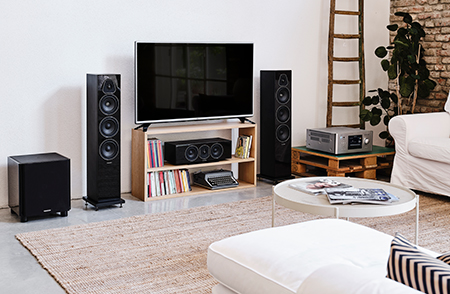
The Lumina III Speakers and Lumina Center I Speaker
Choose Lumina I for a smaller, more compact speaker that can easily slide onto a bookshelf or side table. The Lumina III[1] is a floor-standing speaker that from a design perspective, works very well when positioned on both sides of a media console table to give a room a bit of symmetry. The third speaker option is the Lumina Center I[2], a center channel loudspeaker that boasts a vented box design that is an ideal addition to a console table or home theater. Each speaker in the Lumina collection places an equal emphasis on three descriptors: luxury, minimal, and natural. These three words helped inspire the name of the collection and all play a role in the craftsmanship, design approach, and sound production of these speakers.
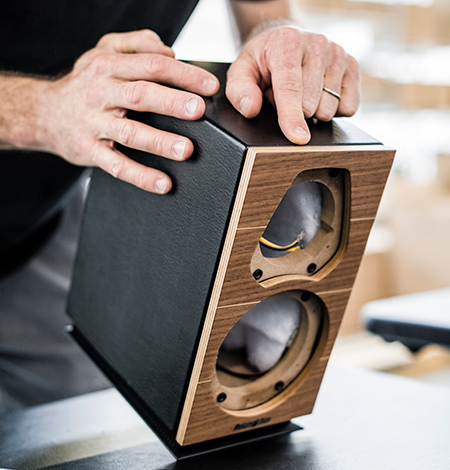
The Lumina I Speaker
The Lumina I[3] option is an easy option for someone looking to integrate stylish sound into their home without being overwhelmed by a larger sized speaker (the Lumina I weighs in at just under ten pounds). The mono-wiring[4] installation is simple as long as you have an amplifier source to power the speakers with. We suggest the MaiA DS2 amplifier[5] that includes a small remote control and can also be controlled through an app. When deciding on where to play your new Lumina I two-way shelf speakers, take into account where your outlets are in comparison to the bookshelf or table you’d like to position your speakers and amplifier on. From there, choose a shorter or longer set of cables to avoid excess wires showing.
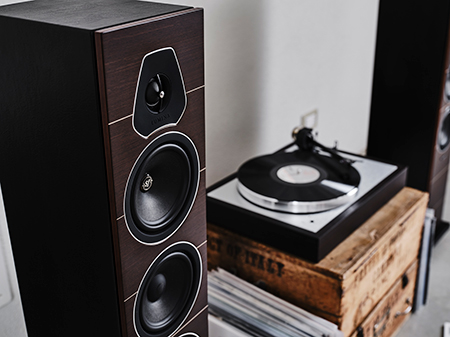
The Lumina III Speaker
The sound quality is so crisp on these speakers that we recommend placing them literally anywhere in your home. But, because they are truly stunning interior design accents, place them in the living room or central area of your home to show off your sound system. Whether you are listening to music throughout the day to reduce your anxiety[6] or bumping up the volume during a colorful cocktail party, Sonus faber will deliver bright, brilliant sound.
2. LIGHTING:
While we love a dramatic lighting fixture, there is a time and place–or rather, a room–for such a design element. Molly Machmer-Wessels, co-founder and designer at Woodland Design Company[7], suggests that the right lighting can shape the story of a room more than furniture can. “In a family room, we’d recommend a recessed lighting design plan that allows even light for a workable space and to utilize the option of lighting that can be dimmed depending on the time of day or type of event. We love the flexibility of dimmable lighting and the impact it can have on quickly transforming a space with the touch of a switch, like from dim and cozy to energetic and bright!”
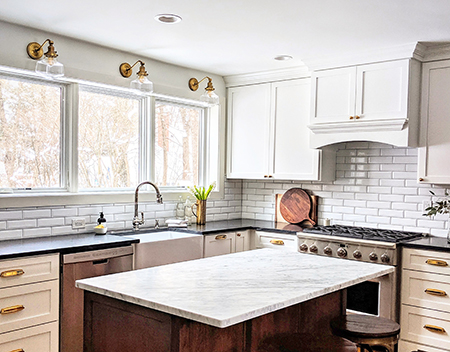
Recessed and wall lighting
Secondary lighting in a family room is a simple way to adjust the overall ambiance of a space. From a chic floor lamp in a corner that will add volume and charisma to a room’s personality to a necessary table lamp by the front door that doubles as a work of art, secondary lighting is key. If you are not ready to pull the trigger on artwork for your home just yet, we suggest choosing a hand-crafted stone lamp from Dumais Made. The brand’s limited edition Deetz Lamp[8] has antique brass fittings and a linen shade, making it a neutral accent with an eclectic twist.
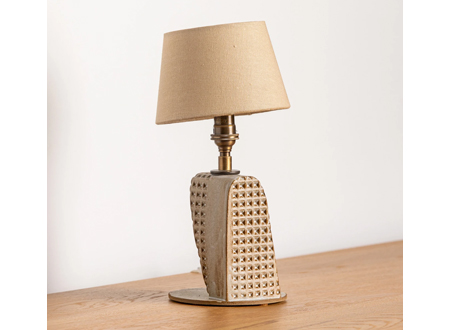
Dumais Made Deetz Lamp
For a more intimate room like a bedroom, Machmer-Wessels suggests focusing on a statement overhead light fixture like a beautiful chandelier or a ceiling fan. Secondary lighting should be used more strategically for specific tasks such as a table lamp next to the bed. “If you have a reading nook or chaise in a bedroom, it’s a great opportunity to add a floor lamp that’s both fashionable and functional, and also helps establish the feeling of a separate-but-same space,” Machmer-Wessels adds.
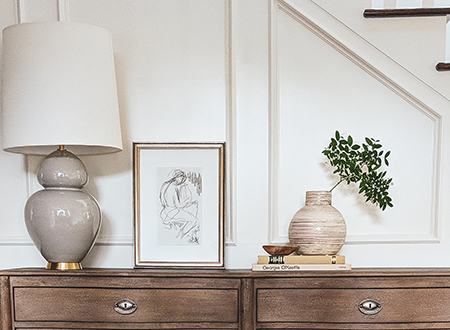
Secondary lighting
3. COLOR PALETTE:
Lastly, a home’s color palette plays a huge role in its energy and general vibe. While a color palette is a huge personal preference, and really depends on what makes you feel a certain way, there are some colors that are typically more stress-inducing than others. For a calm and serene environment, opt for a more neutral color palette with natural textures and even wallpaper.
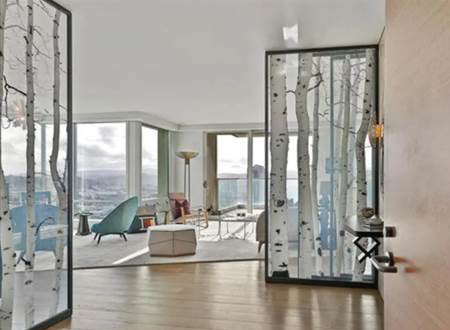
Matthew Millman
Celebrated interior designer, Jay Jeffers[9], suggests wood wall paneling or a white birch tree installation to bring in a sense of the outdoors. “Bringing the outside in creates a serene escape that will elevate the mood of any room, whether you’re looking for a beach or mountain vibe,” Jeffers adds. A neutral color palette can expand beyond creams and shades of white, though. John Cialone of Tom Stringer Design Partners[10] told Elle Decor[11], “In today’s environment, I’m looking to find colors that are calming. A nice blue-gray evokes wellness.” From navy blue to a bold burgundy color to punctuate your interior design, there are plenty of colors that can add harmony to your home.
- Lumina III: https://www.sonusfaber.com/en/products/lumina-iii/
- Lumina Center I: https://www.sonusfaber.com/en/products/lumina-center-i/
- Lumina I: https://www.sonusfaber.com/en/products/lumina-i/
- mono-wiring: https://www.sonusfaber.com/en/2020/04/30/mono-wiring-or-bi-wiring-loudspeakers-a-selection-guide/
- MaiA DS2 amplifier: https://pro-jectusa.com/product/maia-ds2/
- reduce your anxiety: https://www.sonusfaber.com/en/2020/08/20/music-and-its-benefits/
- Woodland Design Company: http://www.woodlanddesign.co/
- limited edition Deetz Lamp: https://www.dumaismade.com/collections/frontpage/products/deetz-lamp-parchment
- Jay Jeffers: https://www.jayjeffers.com/
- Tom Stringer Design Partners: http://www.tomstringer.com/
- Elle Decor: https://www.elledecor.com/design-decorate/color/g29629030/color-trends-2020/
Source URL: https://dujour.com/design/top-3-design-elements-to-create-harmonious-home-sonus-faber-lumina/